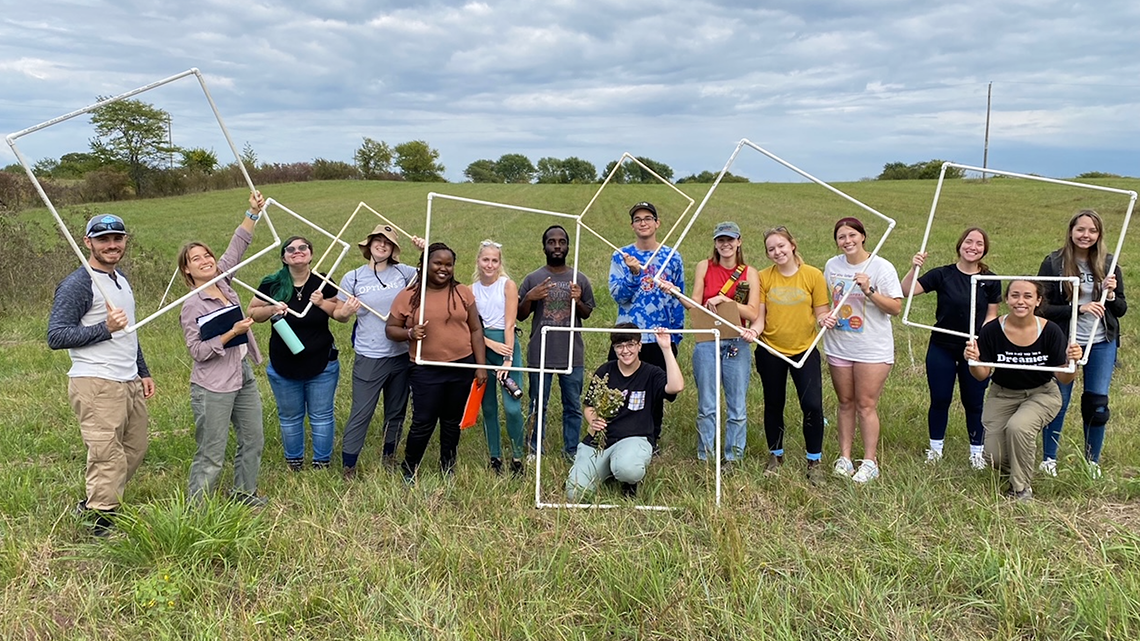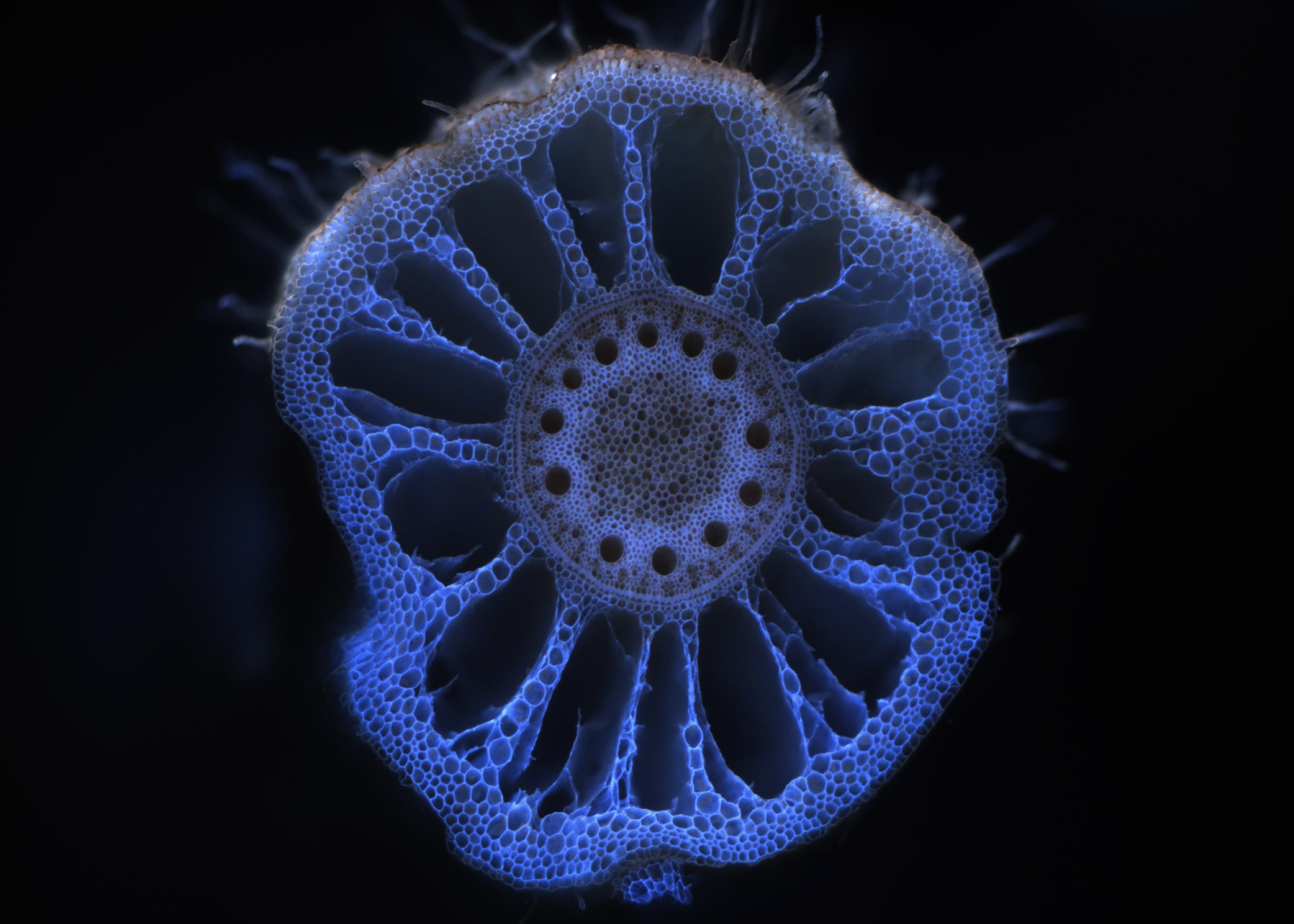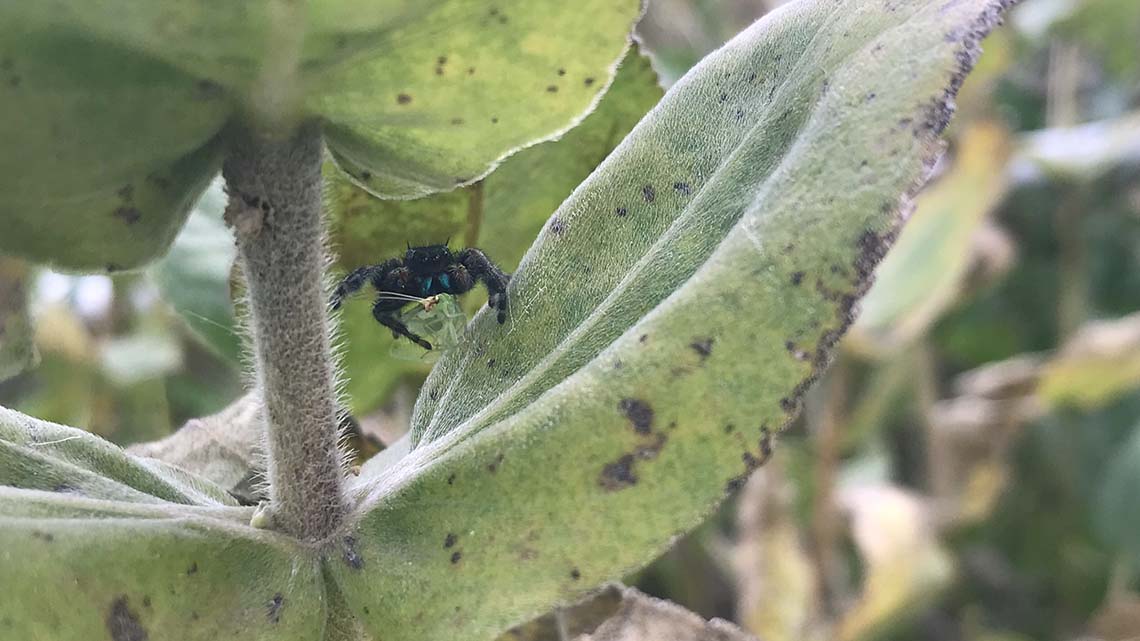Understanding Our Environment

November 2021 Issue
Understanding Our Environment is the internal newsletter for the Kansas Biological Survey & Center for Ecological Research community. Please email biosurvey@ku.edu regarding any errors or omissions.
Photo: Visitors at the Oct. 30 tour of the KU Field Station’s Baldwin Woods Forest Preserve. (Mike Yoder)
Grants
Ligia Souza, doctoral candidate in the Billings Lab, has been selected by the Soil Science Society of America as an Encompass Scholar for the 2021-2022 academic year. The support covers some of her fees for attending the Society’s annual meeting, where she will give an oral presentation. She also will attend a webinar series for professional and leadership development and will have several mentorship opportunities in the coming year. Funding is from Bayer Crop Science.
Dana Peterson, assistant scientist and assistant research professor, PI and coordinator of KansasView, has received an annual grant, $23,500, from AmericaView. This year’s funding is being used for Dana and researcher Jennifer Moody to develop an online ESRI Story Map of the Kansas landscape. The goal is to produce an interactive educational tool about this landscape and how remote sensing can be used to map it. The Story Map will be accessible using a web browser and is being written for public and educational use. It will showcase the recently completed Ecological Vegetation Systems of Kansas land cover map, along with more than 3,000 field locations across the state that have been visited by Kansas Biological Survey & Center for Ecological Research scientists as part of the map development. The Story Map also will include descriptions and photographs of the vegetation, drivers of the Kansas landscape (such as soil, climate, and land use), associated wildlife and links to publicly available locations for in-person exploration. AmericaView is a nationwide, university-led, state-implemented network advancing Earth observation education through remote sensing research, workforce development, technology transfer and community outreach.
Ted Harris, assistant research professor and assistant scientist, has a $100,000 grant from the Kansas Water Office to study Tuttle and Waconda lakes in Kansas; he and his students are looking for long-term changes in water quality, specifically those that relate to Harmful Algal Blooms. (Photo below of Ted with students, left to right, Rebecca Kessler, Kara Kniola, Adeline Kelly and Luke Ungerer, collecting cores at Tuttle last week.) Also, with a $25,000 grant from the City of Paola, the team will monitor Lake Miola, a City of Paola water body, throughout 2022 to better understand seasonal changes in water quality.

Jim Bever has a new $44,000 grant from the Perennial Agriculture Project LLC for the project, “Multitrophic Interactions in Silphium integrifolium: Candidate Perennial Oil Seed Crop.” The grant will support student Amanda Gehin, who will begin the master’s program in EEB in January and bridge the efforts of researchers from KU and The Land Institute, and citizen scientists, in a study of whether isolates from arbuscular mycorrhizal fungi from unplowed prairies improve the defense of this perennial plant against generalist and specialist antagonists. Jim is a senior scientist and Foundation Distinguished Professor of Ecology and Evolutionary Biology.
Publications
Liz Koziol, postdoctoral researcher in the Bever/Schultz Lab,is lead author on a paper, “Manipulating plant microbiomes in the field: Native mycorrhizae advance plant succession and improve native plant restoration,” posted in late September in the Journal of Applied Ecology. The paper described the study’s reintroduction of soil microbiome from native systems at five separate sites across the U.S. and showed that native prairie arbuscular mycorrhizal fungi aided in native prairie plant restoration.
Camille Delavaux, former doctoral student in the Bever/Schultz Lab who graduated in March of this year,now a postdoctoral researcher at ETH Zürich, is lead author on a paper, “Mycorrhizal types influence island biogeography of plants,” in Communications Biology, an open-access journal in the Nature Portfolio. The paper showed that limited dispersal of arbuscular mycorrhizal fungi influenced colonization of islands by plants that depend on them and resulted in higher plant speciation rates after their final establishment.
A paper published in New Phytologist, “Perennial, but not annual legumes synergistically benefit from infection with arbuscular mycorrhizal fungi and rhizobia: a meta-analysis,” provides results of a project led by Susan Magnoli, postdoc in the Bever/Schultz Lab, and sabbatical visitor Silmar Primieri of the Instituto Federal de Santa Catarina in Brazil.
Two additional papers co-authored by Jim Bever are “Microbiome influence on host community dynamics: Conceptual integration of microbiome feedback with classical host-microbe theory” in Ecology Letters, and, in Frontiers in Fungal Biology, “In-depth Phylogenomic Analysis of Arbuscular Mycorrhizal Fungi Based on a Comprehensive Set of de novo Genome Assemblies,” which announces many new AMF genomes that used isolates from the Bever/Schultz Lab and INVAM, the International Culture Collection of (Vesicular) Arbuscular Mycorrhizal Fungi. This is the largest culture collection in the world of this type of fungi, which was moved to KU this year from the West Virginia University. (Photo below shows lab work with a sample in the West Campus Greenhouse facility.)
Presentations
Sharon Billings, along with Larry York of Oak Ridge National Laboratory, gave an Oct. 19 webinar addressing the benefits and challenges of increasing carbon stocks in deep soil. She described how global changes in rooting depth could be changing soil development. The webinar was the sixth in a weekly series, “Critical questions in carbon sequestration,” sponsored by the International Soil Carbon Network in partnership with the Midwest, Northeast and Northwest USDA Climate Hubs and the American Geophysical Union. Sharon is a senior scientist and Dean’s Professor of Ecology and Evolutionary Biology.
Ted Harris gave a presentation, “Harmful Algal Blooms — Impact on humans, animals, and the environment,” on Nov. 2 at Kansas City One Health Day, the local program for the annual international event One Health Day, which is focused on the interrelationships among human, animal and environmental health. The local event is a collaboration of BioNexus KC, the KU Edwards Campus and the KU Medical Center.
Amy Burgin presented one of the four six-minute talks given by members of the KU community Sept. 24 at Red Hot Research No. 66, Climate, Culture, Communication, held at The Commons at KU. Her presentation labels were Local, Climate Change, Informed Conversations. Amy is an associate scientist and an associate professor of EEB.
Liz Koziol will present this Friday, Nov. 12, at Red Hot Research No. 69, Interspecies Entanglements, Humans in a More Than Human World. She will discuss the interactions of plants and mycorrhizal fungi and their role in prairie restoration.
Laura Podzikowski (top left in the KU 3MT montage above), doctoral student in the Bever/Schultz Lab, was one of 20 KU graduate students taking part in the 2021 3MT® Competition at KU — Three Minute Thesis, an academic research communication competition for graduate students in which they present their research and its value and impact on the world to nonspecialist audiences. Laura summarized four years’ worth of research in a presentation about why plant communities grow larger with diversity. Also in the competition was Chen Liang, doctoral student in geography and atmospheric science, who gave a presentation (photo below), on the Sentinal GreenReport Google Earth Engine App, which she developed this summer working with Dana Peterson and Jude Kastens, associate scientist and associate research professor, and Xingong Li, professor of geography and atmospheric science and an affiliate of our center, under funding from KansasView. The 3MT competition takes place in two rounds, the first held Nov. 1-5, the final round Nov. 15-19, with judges choosing first- and second-place winners. The first-place winner will represent KU at the Midwestern Association of Graduate Schools 3MT competition in April 2022. The competition began in 2008 at the University of Queensland and is now held at more than 900 universities in 85 countries. This is the third year it has been held at KU.
Publicity
Sharon Billings was one of several researchers interviewed by Science magazine for its article “New observatory to probe the mysteries of Earth’s ‘forgotten’ subsoil” about the Deep Soil Ecotron, a facility to be built over the next five years at the University of Idaho with $19 million in National Science Foundation funding. The article reports that about a dozen ecotron facilities exist, most in Europe, but that while these allow researchers to study just one or two soil conditions, the planned facility will make it possible to manipulate far more factors. One key goal is to provide the capacity to study how carbon responds to climate change.
Jude Kastens is one of the sources interviewed in the forthcoming episode of “Real Ag” (Episode 1002 — Government Policy), which premieres this Friday, Nov. 12, at 8:30 p.m. on Smoky Hills PBS and also will be available at that time on YouTube. “Real Ag,” a Smoky Hill public television program on issues affecting agriculture, is now in its 10th season.
Fundraising Effort for Ecology
Three KU units are working together — the Dept. of Ecology & Evolutionary Biology, the Environmental Studies Program, and the Kansas Biological Survey & Center for Ecological Research — on a major fundraising effort in support of KU student field courses. Funding is needed for supplies, tools and equipment, transportation, and graduate student support, with the goal of increasing access to KU field courses and specifically leveraging the resources of the nearby KU Field Station. The fundraising campaign — “Take it Outside!” — will be administered through KU Endowment’s LaunchKU online platform and is expected to open in late November. An anonymous $12,000 gift has been made to get the campaign started. More information to come. (Photo below of BIOL415 class shared by Haley Burrill, second from left, doctoral student in the Bever/Schultz Lab, and Bryan Foster, senior scientist, professor of EEB and Field Station director.)

Your Photos
Maggie Wagner, assistant scientist and assistant professor of EEB, shares the image below showing a cross section of an Eastern gamagrass root (Tripsacum dactyloides), cut and imaged using Laser Ablation Tomography. The root is a sample from an experiment being done here by Nichole Ginnan, postdoctoral researcher in the Wagner Lab. Nichole is investigating how the adaptation of soil microbes to drought changes the way they interact with plants, including their effects on root anatomy; the root structures seen in this image affect the drought tolerance of the plant. This image was taken by Wagner Lab collaborators Gabriel Castrillo and Valéria Custódio at the University of Nottingham, U.K. 
Reb Bryant, doctoral student in the Bever/Schultz Lab, has been at work in the field and shares this photo of a jumping spider capturing a lacewing.
KU Field Station
The KUField Station staff is planning a prescribed burn of part of the Rice Woodland tract of the Baldwin Woods Forest Preserve soon, when leaf drop and weather align. The burn could take place next week (Nov. 15-19) or in early December. The 80-acre tract was transferred from The Nature Conservancy to KU Endowment in the 1970s through funding from the Ethel and Raymond F. Rice Foundation. The majority of the tract is relatively undisturbed eastern deciduous forest. The prescribed burn, a traditional management tool, is needed to control the encroaching invasive plant species in the understory. The Lawrence and Baldwin City communities will be notified of plans and dates in advance.
In the Field
Progress continues on a pollinator and grassland habitat improvement project funded by a $34,800 grant from the Douglas County Heritage Conservation Council. Mike Houts, associate researcher and PI on the grant, coordinated with the Lawrence Parks Department and Native Lands LLC this week to burn a 10-acre brome pasture at the Mutt Run off-leash dog park below Clinton reservoir. The burn was the first step to clear the overgrowth in preparation for seeding with a mixture of native grasses and pollinator-friendly forbs later this winter and a planting of about 1,500 wildflower seedling plugs in the spring. An ArcGIS Story Map web page developed by Mike and co-PI Jennifer Delisle, associate researcher, describes the project.
Debbie Baker, associate researcher, and Haskell Indian Nations University faculty member Bridgett Chapin are co-mentoring two Haskell students, Garrett Williams and Jamie Stallings, who placed camera traps in the Haskell wetlands to monitor animal use of both the wetlands and underpasses below the South Lawrence Trafficway. The study is partially supported by a grant, held by Bridgett, from the Kansas Idea Network of Biomedical Research Excellence. Jamie also assists Debbie with a study of the Wakarusa River for the City of Lawrence and is applying that monitoring to the study at the Haskell wetlands.es in the understory. The Lawrence and Baldwin City communities will be notified of plans and dates in advance.